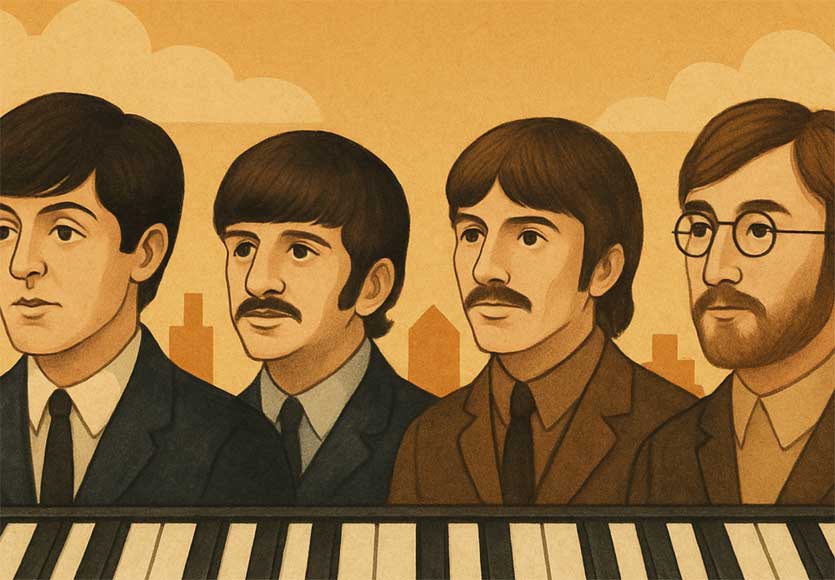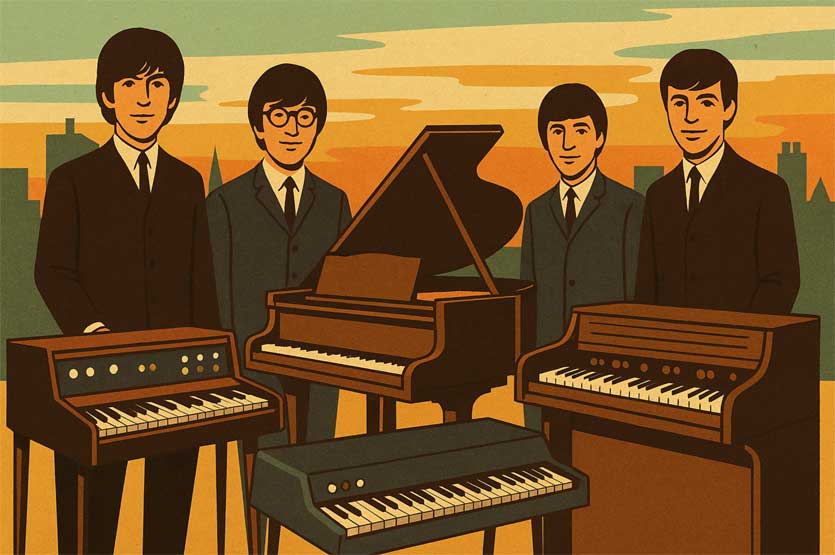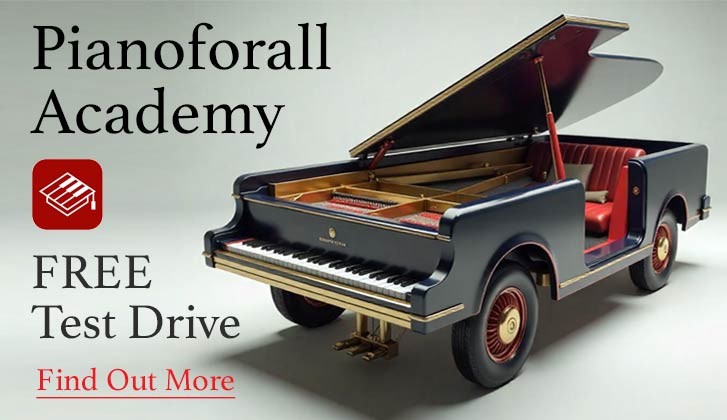What if the “guitar band” wasn’t only a guitar band?
Yes, you can learn almost any Beatles song on piano. And while the Fab Four are often framed as a guitar-first band, their catalogue is packed with keyboard fingerprints — from the iconic Let It Be to the carnival swirl of Mr. Kite. Below is a tour of the six pianists who shaped the Beatles’ sound, plus a few postscripts for deeper digging.
Let It Be: A Keyboard Classic
On the album version of Let It Be you’ll hear three keyboards:
- Paul McCartney on a Blüthner piano
- Hammond organ
- Electric piano
It’s quintessentially a keyboard track — and it isn’t the only one.
Hey Jude and Beyond
Think of Hey Jude: McCartney at a Bechstein piano, carrying a seven-minute anthem. Hardly an outlier when you consider how often keyboards show up throughout their catalogue.
Paul McCartney: Prolific on the Keys
McCartney played some form of keyboard on 48 Beatles songs. Examples include:
- Piano on Golden Slumbers and Hello, Goodbye
- Celeste on The Fool on the Hill
- Harmonium on Penny Lane
- Mellotron on Strawberry Fields Forever
- Moog synthesiser on Maxwell’s Silver Hammer
- Hammond organ on I Me Mine
- Organ on Sgt. Pepper’s Lonely Hearts Club Band
John Lennon: 28 Keyboard Credits
Lennon also logged substantial time at the keys:
- Piano on Come Together and Mean Mr. Mustard
- Electric piano on I Am the Walrus and The Night Before
- Harpsichord on All You Need Is Love
- Hammond organ on Being for the Benefit of Mr. Kite! and Sexy Sadie
- Harmonium on We Can Work It Out
George Martin: The Fifth Beatle at the Keyboard
Producer George Martin — a classically trained musician who studied at the Guildhall School of Music — played piano and other keyboards on 27 Beatles songs, just one fewer than Lennon. His parts and production ideas massively expanded the band’s harmonic palette and studio imagination.
Billy Preston: The Secret Weapon
Virtuoso Billy Preston appears on Let It Be (Hammond organ and electric piano) and a total of 10 Beatles recordings. He is the friendly face at the keys on the famous 1969 rooftop performance at Apple Corps on Savile Row. The Beatles first crossed paths with him in Hamburg, where Preston was backing Little Richard while the group played marathon club sets. Later, he became a go-to session player for stars including Sam Cooke, the Everly Brothers and Ray Charles — and he continued collaborating with ex-Beatles after 1970.
Chris Thomas: A Brief but Notable Cameo
Part of the production team during the White Album, Chris Thomas contributed:
- Piano on Long, Long, Long
- Harpsichord on Piggies
- Mellotron on The Continuing Story of Bungalow Bill
Nicky Hopkins: The Session Man
Nicky Hopkins — the legendary session pianist/organist who recorded with The Rolling Stones, The Kinks, The Who, Rod Stewart, Carly Simon, Art Garfunkel, Joe Cocker, Cat Stevens, and all four ex-Beatles — appeared on a single Beatles release: the electric piano on Revolution (the B-side to Hey Jude, 1968). Hopkins, a Royal Academy of Music alumnus, battled Crohn’s disease and died in 1994, aged 50. For a fuller portrait, see Julian Dawson’s biography And On Piano… Nicky Hopkins and the 2023 documentary The Session Man.
So… Guitar Band?
Add up the credits and you’ll find that these six pianists — McCartney, Lennon, Martin, Preston, Thomas and Hopkins — played keyboards on over half of the Beatles’ recordings. Not bad for a so-called guitar band.

Postscripts
1) Mal Evans: The Trusted Fixer
Bodyguard, driver, tour manager and all-purpose problem-solver, Mal Evans started as a Cavern Club bouncer and became a near-constant presence at sessions after 1966. His uncredited musical bits were many (chorus on Yellow Submarine; harmonica on Being for the Benefit of Mr. Kite!; tambourine on Dear Prudence; trumpet on Helter Skelter). Under McCartney’s guidance he also played a Hammond organ line on You Won’t See Me (Rubber Soul). Evans died in 1974. For a full account, see Kenneth Womack’s 2023 book Living The Beatles Legend: The Mal Evans Story.
2) “Martha My Dear” — A Pianist’s Challenge
Try accompanying Martha My Dear on piano and singing it. With its embellished chords, syncopation and key shifts, it’s a handful as a solo recital piece. McCartney himself once said he wrote it like a “little set piece,” slightly above his comfort level (Barry Miles, Paul McCartney: Many Years from Now, 1998).
3) “The Long and Winding Road” — Seek the Leaner Mixes
If you only know the Let It Be version soaked in Phil Spector strings, hunt down the alternatives: Let It Be… Naked (2003) and Anthology 3 (1996) offer more piano-forward, McCartney-approved takes.
4) A Personal Note: “Golden Slumbers”
My own favourite Beatles song with piano is Golden Slumbers from Abbey Road. Its lullaby warmth and McCartney’s vocal felt deeply consoling when my father died — and it still does. Golden slumbers fill your eyes, Bertie. As someone once sang over the strains of a piano:
“And in the end,
The love you take,
Is equal to,
The love you make.”



